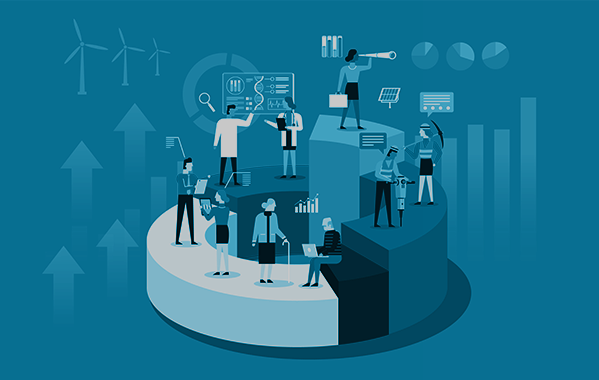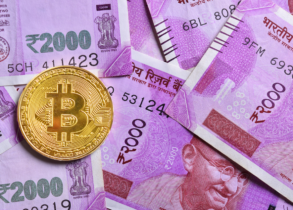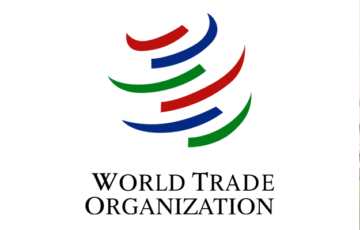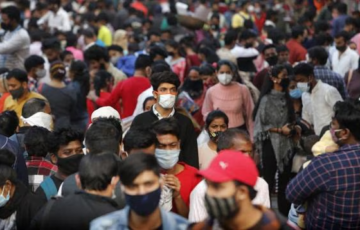INCLUSIVE GROWTH
Introduction
- Inclusive growth is a concept that emphasizes fair distribution of resources, ensuring that all segments of society benefit. The World Bank views it as a balance between the rate and structure of growth, while the UNDP sees it as a process where everyone participates and gains equally. The OECD defines it as economic growth that provides opportunities for all and distributes the benefits fairly, including non-monetary aspects.
- The concept gained prominence in India with the 11th Five-Year Plan, which emphasized inclusive growth, a focus continued in the 12th Five-Year Plan. The current approach to growth aims to be faster, inclusive, and sustainable.
Feature of Inclusive Growth
- Poverty Reduction: Inclusive growth aims to reduce poverty and improve the living standards of the poorest members of society. This can be achieved through policies that create jobs, increase wages, and improve access to social safety nets.
- Improved Income Distribution: Inclusive growth is not just about increasing the overall size of the economy. It is also about ensuring that the benefits of growth are shared more widely. This means reducing income inequality and creating a more equitable distribution of wealth.
- Equal Access to Opportunities: Inclusive growth means creating a level playing field where everyone has the opportunity to succeed. This includes ensuring equal access to education, healthcare, and other essential services.
- Empowerment of Marginalized Groups: Inclusive growth pays particular attention to the needs of marginalized groups, such as women, minorities, and people with disabilities. It aims to empower these groups and remove the barriers that prevent them from participating fully in the economy.
- Social Mobility: Inclusive growth fosters social mobility, which is the ability of people to move up the economic ladder. This means creating opportunities for people to improve their job skills and qualifications, and to advance to better-paying jobs.
- Environmental Sustainability: Inclusive growth recognizes that economic growth must be sustainable in the long term. This means taking into account the environmental impact of economic activity and ensuring that growth does not come at the expense of the environment.
Need for Inclusive Growth
- Reducing Inequality: Inclusive growth aims to reduce income and wealth disparities among different segments of society, ensuring that the benefits of economic growth are more evenly distributed.
- Social Cohesion: By ensuring that all groups participate in and benefit from growth, inclusive policies can help promote social harmony and reduce potential conflicts arising from economic disparities.
- Poverty Alleviation: Inclusive growth can help lift people out of poverty by providing them with opportunities for economic advancement and improving their access to essential services.
- Sustainable Development: Inclusive growth emphasizes sustainable development that meets the needs of the present without compromising the ability of future generations to meet their own needs.
- Enhanced Economic Stability: When more people have access to economic opportunities, it can lead to a more stable economy as a diverse range of industries and sectors contribute to growth.
- Improved Productivity: Inclusive growth can lead to a more skilled and productive workforce, which can contribute to overall economic growth and competitiveness.
- Political Stability: Inclusive growth can contribute to political stability by addressing grievances related to economic exclusion and marginalization.
Elements of Inclusive Growth
| Skill Development | The demographic dividend’s realization depends on the employability of the working-age population, along with their health, education, vocational training, and skills. |
| Financial Inclusion | Financial inclusion involves providing economically disadvantaged individuals with affordable access to financial services. It is crucial for inclusive growth as it promotes a culture of saving, initiating a positive cycle of economic advancement. |
| Technological Progress | The world is entering the era of the Fourth Industrial Revolution. Technological advancements have the potential to either reduce or exacerbate inequality, depending on their application. |
| Economic Development | India boasts one of the world’s fastest-growing major economies. However, it is currently experiencing a slowdown due to both cyclical and structural factors. Achieving a $5 trillion economy by 2024-25 can aid India in reducing inequality, enhancing social spending, and creating employment opportunities for all. |
| Social Development | Social development involves empowering all marginalized communities, including SC/ST/OBC/Minorities, women, and transgender individuals. This empowerment can be achieved by enhancing social institutions such as hospitals, particularly primary healthcare in rural areas, schools, and universities. Investing in social structures will not only benefit the economy through fiscal stimulus but will also result in a healthy and skilled workforce for the future. |
Approaches to Inclusive Growth
- Trickle-Down Approach: This approach suggests that when the wealthy and businesses benefit from economic growth through tax breaks and incentives, these benefits will eventually “trickle down” to the lower income groups. It relies on the assumption that policies benefiting the upper echelons of society will result in broader economic prosperity.
- Welfare Approach: The welfare approach focuses on the fair distribution of resources and goods to maximize overall social welfare. It emphasizes the importance of social safety nets, healthcare, education, and other services to ensure a basic standard of living for all members of society.
- Bottom-Up Approach: In contrast to the top-down nature of the trickle-down approach, the bottom-up approach emphasizes the active participation of individuals and communities in the development process. It advocates for empowering people at the grassroots level to drive inclusive growth from the bottom of the socioeconomic pyramid.
- Public Relations Approach: This approach emphasizes the importance of communication and engagement to encourage public participation in the inclusive growth process. It involves using social and psychological factors to motivate individuals and communities to actively contribute to development initiatives.
- Coordinated Approach: Inclusive growth projects often require coordination among various stakeholders, including government agencies, non-governmental organizations, and community groups. This approach highlights the need for a well-coordinated strategy for planning, funding, and executing projects to ensure that goals are shared and roles are clearly defined.
- Strategic Approach: The strategic approach recognizes that there is no one-size-fits-all solution to promoting inclusive growth. It advocates for a combination of programs and policies that address various aspects of inequality and exclusion, such as integrating marginalized groups into the workforce, tackling gender discrimination, promoting social innovation, supporting low-income families, and enhancing digitalization in rural and remote areas.
Dimensions of Inclusive Growth
- Equality is a fundamental principle that aims to ensure everyone has equal access to resources, markets, and a fair regulatory environment. Inclusive growth, which encompasses equality, is essential for equitable development. Good governance plays a crucial role in supporting equality by upholding justice, the rule of law, and accountability, while promoting public engagement and consensus.
- Decentralization, particularly through strengthening local self-governance institutions, is a key approach to achieving inclusive growth. The constitution’s 73rd and 74th amendments in India are innovative steps in this direction. To make these institutions effective facilitators of inclusive growth, they need to be empowered by both federal and state governments.
- Transparency and accountability are vital components of good governance. Accountability involves being held responsible for the effectiveness of service delivery and ensuring that tasks are completed efficiently. Checks and balances, such as independent agencies like the CAG and PMO, play a crucial role in ensuring accountability in governmental actions.
- Sustainability is another critical aspect of inclusive growth. While economic planning for inclusive growth has shown significant results, there are concerns about its long-term impact on the environment and the standard of living for the poor. The challenges surrounding inclusive growth, including Liberalization, Privatization, and Globalization (LPG), have had adverse effects on the environment and have widened the rural-urban gap. Achieving sustainability and inclusive growth requires a holistic approach, as they are interdependent and mutually reinforcing.
India @75 by NITI Aayog and Inclusive Growth
- NITI Aayog, the National Institution for Transforming India, plays a significant role in shaping the country’s development agenda. As India celebrated its 75th year of independence in 2021, NITI Aayog outlined several initiatives and goals under the theme “India@75” to promote inclusive growth and sustainable development.
- Vision for New India: NITI Aayog envisioned a “New India” by 2022 (coinciding with India@75), focusing on a sustainable and inclusive growth model that addresses social, economic, and environmental challenges.
- Sustainable Development Goals (SDGs): NITI Aayog has been instrumental in aligning India’s development agenda with the United Nations Sustainable Development Goals, aiming for a holistic approach to eradicate poverty, improve health and education, and ensure environmental sustainability.
- Aspirational Districts Program: This program targets some of the most underdeveloped districts in the country, aiming to improve their socio-economic status through a focus on health, education, agriculture, water resources, financial inclusion, and skill development.
- Atmanirbhar Bharat (Self-reliant India): NITI Aayog has been a key player in formulating policies for the Atmanirbhar Bharat initiative, which aims to boost domestic manufacturing, reduce dependency on imports, and create jobs, thereby fostering inclusive growth.
- Digital India: Emphasizing the role of digital technology in inclusive growth, NITI Aayog has supported various initiatives to enhance digital infrastructure, improve access to government services through digital platforms, and promote digital literacy.
- Agricultural Reforms: NITI Aayog has advocated for reforms in agriculture to increase farmers’ income, promote sustainable farming practices, and ensure food security, contributing to rural inclusive growth.
- Healthcare Initiatives: Initiatives like Ayushman Bharat aim to provide affordable healthcare to the poor and vulnerable sections of society, aligning with the goal of inclusive growth by ensuring that no one is left behind in accessing essential health services.
- Women Empowerment: NITI Aayog has focused on policies and programs to empower women, recognizing their vital role in achieving inclusive growth. This includes efforts to improve women’s access to education, healthcare, and economic opportunities.
Obstacles to Achieving Inclusive Growth in India:
- Poverty:
- Multidimensional Poverty Index: India has made tremendous strides in decreasing multidimensional poverty. The most recent National Multidimensional Poverty Index (2023) shows the share of the population living in multidimensional poverty has dropped from 24.85% (NFHS-4, 2015-16) to 14.96% (NFHS-5, 2019-21). However, 373 million Indians still face extreme deprivation, with 8.8% living in severe multidimensional poverty and 19.3% at risk of falling into it.
- Unemployment:
- Labor Force Survey: The NSSO’s Periodic Labor Force Survey (PLFS) reported urban unemployment at 7.8% and rural at 5.3%, leading to an overall rate of 6.1%. Factors like illiteracy and overreliance on agriculture contribute to low employment quality and quantity.
- Informal Economy: Over 80% of workers are in the informal economy, which raises concerns about employment quality.
- Agriculture Regression:
- Employment vs. GDP Contribution: Agriculture employs 44% of Indians but contributes only 16.5% to GDP, leading to widespread poverty.
- Issues: Challenges include decreasing land availability per capita, a shrinking employment share, and low labor productivity.
- Social Development Issues:
- Challenges: Social development, crucial for inclusive growth, faces problems such as significant regional, socioeconomic, and gender disparities; modest and slowly growing public spending, especially in health and education; subpar delivery systems; and lower social indices for OBC, SC, ST, and Muslim communities.
- Regional Disparities:
- Concerns: Factors like the caste system and wealth differences contribute to regional disparities, resulting in unequal opportunities.
- Examples: Kerala has a high literacy rate of 93.1%, while Bihar’s is only 63.82%. Goa’s per capita income in 2018 was Rs 4,67,998, compared to Bihar’s Rs 43,822.
- Social Enterprises:
- Role: Social enterprises are crucial for India’s inclusive growth agenda, but they lack official recognition as a sector, unlike in many other countries.
- Land Reform:
- Issue: Inadequate land reform is a major factor hindering India’s progress toward inclusive growth and distributive justice.
Measuring (Indices and Reports) Inclusive Growth
| Index/Report | Description |
| Index of Inclusive Development | – India ranked 62nd out of 74 emerging countries in the World Economic Forum’s (WEF) Inclusive Development Index (IDI), making it one of the least inclusive countries in the G-20. |
| – Parameters: The IDI is based on the premise that most individuals base their country’s growth on their level of life rather than GDP. | |
| – Factors: It calculates inequality based on growth, development, and poverty. | |
| Index of Social Progress (SPI) | – It is a composite index of social and environmental factors that include human necessity, the foundation of happiness, and opportunity. |
| – Limitations: Non-market activities are not included in GDP, and factors like the environment and equality are not considered. | |
| Global Slavery Index | – Publisher: Released by The Walk Free Foundation of Australia. |
| – Definition: Modern slavery refers to a scenario in which one individual denies another person’s freedom to control their body and exploits them. |
World Economic Forum and Inclusive Growth
- The World Economic Forum (WEF) is actively engaged in promoting inclusive growth through various initiatives and collaborations. Some of the key efforts by the WEF to foster inclusive growth are as follows:
- Resilience for Sustainable Inclusive Growth: The WEF, in collaboration with McKinsey & Company, has developed a white paper titled “Resilience for Sustainable Inclusive Growth.” This paper outlines the objectives of the Resilience Consortium, a public-private leadership group focused on building resilience for sustainable and inclusive growth.
- Shaping an Inclusive Global Economy: The WEF is working on scaling impactful corporate Diversity, Equity, and Inclusion (DEI) initiatives to shape a more inclusive global economy. This effort involves identifying and promoting corporate DEI initiatives that have demonstrated a positive impact.
- Digital Transformation for Long-Term Growth: The WEF’s Digital Transformation initiative explores strategies and solutions for global digital innovation. By fostering digital transformation, the WEF aims to drive long-term growth that is inclusive and sustainable
UPSC PREVIOUS YEAR QUESTIONS
1. The main objective of the 12th Five-Year Plan is _________ (2014)
1. inclusive growth and poverty reduction.
2. inclusive and sustainable growth
3. sustainable and inclusive growth to reduce unemployment
4. faster, sustainable and more inclusive growth
2. Which of the following can be said to be essentially the parts of ‘Inclusive Governance? (2012)
1. Permitting the Non-Banking Financial Companies to do banking.
2. Establishing effective District Planning Committees in all the districts.
3. Increasing government spending on public health.
4. Strengthening the Mid-day Meal Scheme.
Select the correct answer using the codes given below:
(a) 1 and 2 only
(b) 3 and 4 only
(c) 2, 3 and 4 only
(d) 1, 2, 3 and 4
3. Explain intra-generational and intergenerational issues of equity from the perspective of inclusive growth and sustainable development. (2020)
4. What are the salient features of ‘inclusive growth’? Has India been experiencing such a growth process? Analyze and suggest measures for inclusive growth. (2017)
5. Comment on the challenges for inclusive growth which include careless and useless manpower in the Indian context. Suggest measures to be taken for facing these challenges. (2016)
6. Pradhan Mantri Jan-Dhan Yojana (PMJDY) is necessary for bringing the unbanked to the institutional finance fold. Do you agree with this for the financial inclusion of the poorer section of Indian society? Give arguments to justify your opinion. (2016)
7. Capitalism has guided the world economy to unprecedented prosperity. However, it often encourages short-sightedness and contributes to wide disparities between the rich and the poor. In this light, would it be correct to believe and adopt capitalism driving inclusive growth in India? Discuss. (2014)










